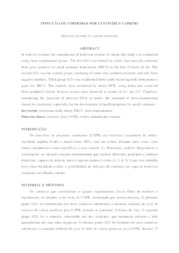Infecção de cordeiros por lentivírus caprino.
Infecção de cordeiros por lentivírus caprino.
Author(s): SOUZA, T. S. de; PINHEIRO, R. R.; LIMA, C. C. V. de; ANDRIOLI, A.; AZEVEDO, D. A. A. de; SANTOS, W. W. S. dos; SOUZA, A. L. M. de; ARAÚJO, J. F.; PINHEIRO, D. N. dos S.; COSTA, J. N.
Summary: [Infection of lambs by caprine lentivirus]. Abstract: In order to evaluate the transmission of lentivirus of goats to sheep, this study was conducted using three experimental groups. The first (G1) was formed by lambs that received colostrum from goats positive for small ruminant lentiviruses (SRLV) in the first 24 hours of life. The second (G2) was the control group, consisting of lambs that suckled colostrum and milk from negative mothers. Third group (G3) was established from lambs receiving milk from positive goats for SRLV. The animals were monitored by nested PCR, using leukocytes extracted from peripheral blood. Positive results were observed in lambs of G1 and G3. Therefore, considering the detection of proviral DNA in lambs, the potential of cross-transmission should be considered, especially for the development of health programs for small ruminants.
Publication year: 2013
Types of publication: Paper in annals and proceedings
Unit: Embrapa Goats & Sheep
Keywords: Animal diseases, CAE, CAEV, Colostro, Colostrum, Cordeiro, Doença animal, LVPR, Lambs, Leite, Lentivirose, Lentivirus, Milk, Ovino, Sheep, Transmissão cruzada, Transmissão de doença, Vírus
Observation
Some of Embrapa's publications are published as ePub files. To read them, use or download one of the following free software options to your computer or mobile device. Android: Google Play Books; IOS: iBooks; Windows and Linux: Calibre.
Access other publications
Access the Agricultural Research Database (BDPA) to consult Embrapa's full library collection and records.
Visit Embrapa Bookstore to purchase books and other publications sold by Embrapa.

